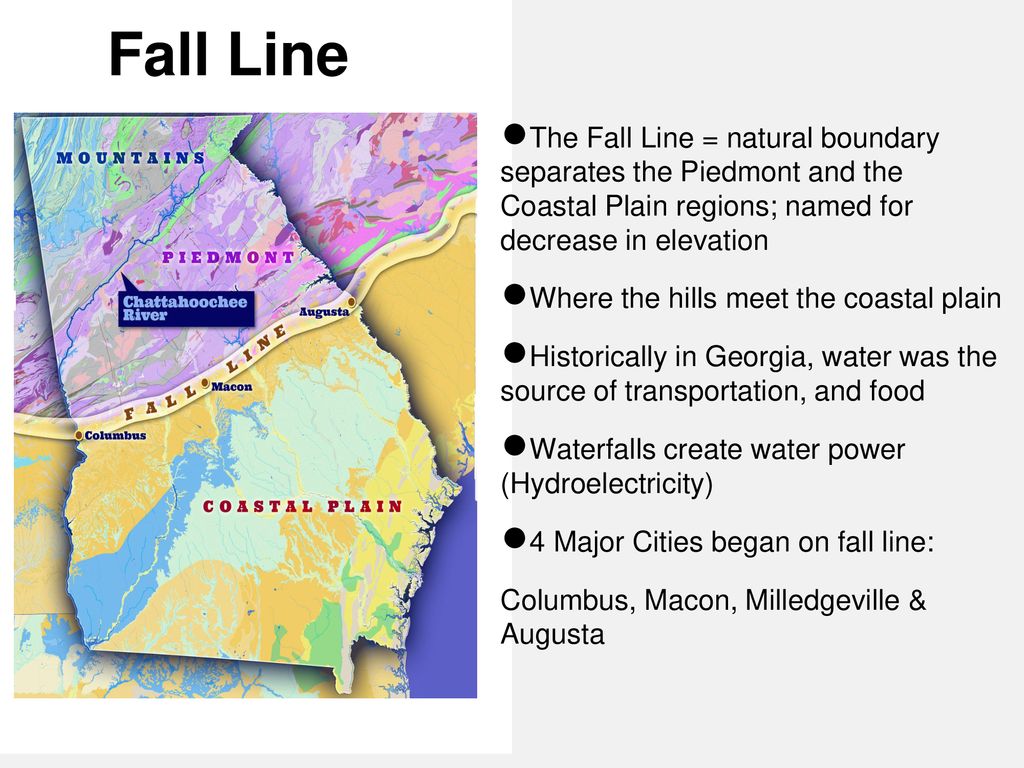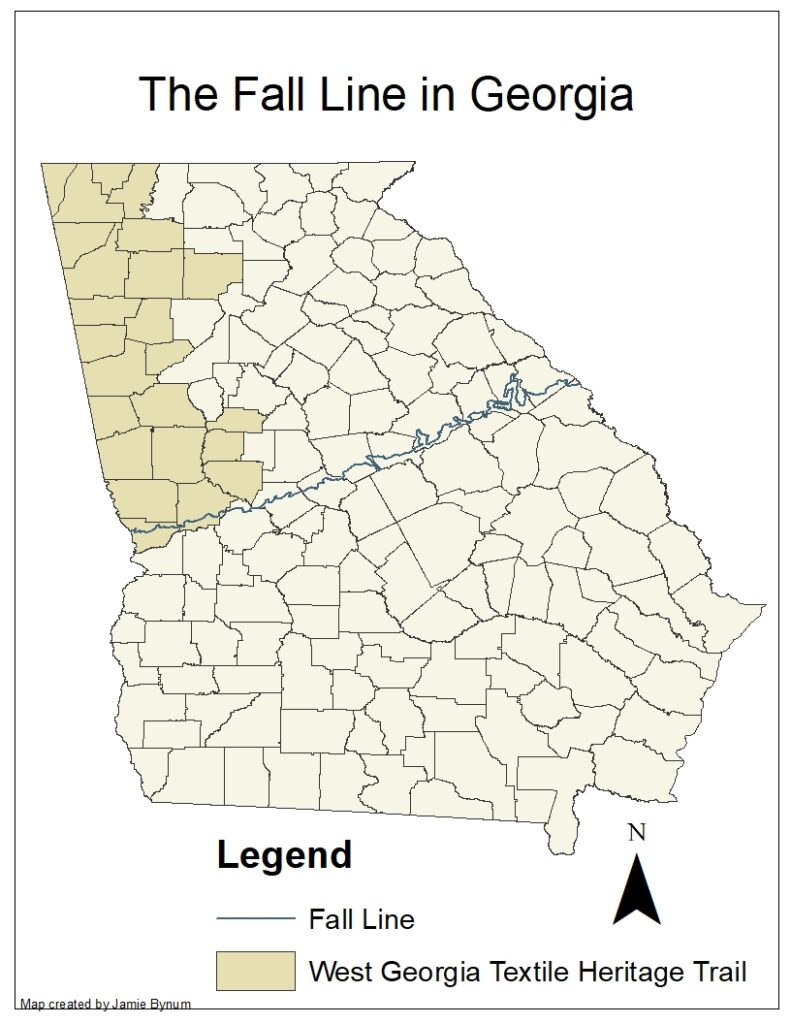What Is The Fall Line In Georgia
What Is The Fall Line In Georgia - It is a gently sloping region that. First, it served as a natural boundary for boat traffic traveling upstream, which led to the development of important trade. In georgia, the four cities on the fall line are columbus, macon, milledgeville, and augusta. Georgia’s fall line is a geologic boundary marking the prehistoric shoreline of the atlantic ocean as well as the division between the piedmont and coastal plain regions of the. Georgia’s fall line is significant for several reasons. Georgia’s fall line is a geologic boundary marking the prehistoric shoreline of the atlantic ocean as well as the division between the piedmont and coastal plain regions of the state. The fall line is a geological boundary, about twenty miles wide, running northeast across georgia from columbus to augusta. These cities developed along rivers such as the chattahoochee, ocmulgee, oconee, and.
In georgia, the four cities on the fall line are columbus, macon, milledgeville, and augusta. First, it served as a natural boundary for boat traffic traveling upstream, which led to the development of important trade. Georgia’s fall line is a geologic boundary marking the prehistoric shoreline of the atlantic ocean as well as the division between the piedmont and coastal plain regions of the state. Georgia’s fall line is significant for several reasons. These cities developed along rivers such as the chattahoochee, ocmulgee, oconee, and. The fall line is a geological boundary, about twenty miles wide, running northeast across georgia from columbus to augusta. Georgia’s fall line is a geologic boundary marking the prehistoric shoreline of the atlantic ocean as well as the division between the piedmont and coastal plain regions of the. It is a gently sloping region that.
Georgia’s fall line is significant for several reasons. In georgia, the four cities on the fall line are columbus, macon, milledgeville, and augusta. The fall line is a geological boundary, about twenty miles wide, running northeast across georgia from columbus to augusta. These cities developed along rivers such as the chattahoochee, ocmulgee, oconee, and. Georgia’s fall line is a geologic boundary marking the prehistoric shoreline of the atlantic ocean as well as the division between the piedmont and coastal plain regions of the state. Georgia’s fall line is a geologic boundary marking the prehistoric shoreline of the atlantic ocean as well as the division between the piedmont and coastal plain regions of the. It is a gently sloping region that. First, it served as a natural boundary for boat traffic traveling upstream, which led to the development of important trade.
Fall Line Map United States Map States District
The fall line is a geological boundary, about twenty miles wide, running northeast across georgia from columbus to augusta. Georgia’s fall line is a geologic boundary marking the prehistoric shoreline of the atlantic ocean as well as the division between the piedmont and coastal plain regions of the. In georgia, the four cities on the fall line are columbus, macon,.
Fall Line Tugaloo Dam Outdoor, Fall, Line
First, it served as a natural boundary for boat traffic traveling upstream, which led to the development of important trade. Georgia’s fall line is a geologic boundary marking the prehistoric shoreline of the atlantic ocean as well as the division between the piedmont and coastal plain regions of the state. In georgia, the four cities on the fall line are.
Historic Mill Dams The Fall Line
Georgia’s fall line is a geologic boundary marking the prehistoric shoreline of the atlantic ocean as well as the division between the piedmont and coastal plain regions of the state. In georgia, the four cities on the fall line are columbus, macon, milledgeville, and augusta. Georgia’s fall line is a geologic boundary marking the prehistoric shoreline of the atlantic ocean.
Fall Line divides the state
It is a gently sloping region that. Georgia’s fall line is significant for several reasons. The fall line is a geological boundary, about twenty miles wide, running northeast across georgia from columbus to augusta. First, it served as a natural boundary for boat traffic traveling upstream, which led to the development of important trade. Georgia’s fall line is a geologic.
Using Native Plants Water Tumbles Down the Fall Line
Georgia’s fall line is a geologic boundary marking the prehistoric shoreline of the atlantic ocean as well as the division between the piedmont and coastal plain regions of the state. The fall line is a geological boundary, about twenty miles wide, running northeast across georgia from columbus to augusta. First, it served as a natural boundary for boat traffic traveling.
Fall Line New Encyclopedia Geology, Geography,
Georgia’s fall line is a geologic boundary marking the prehistoric shoreline of the atlantic ocean as well as the division between the piedmont and coastal plain regions of the state. First, it served as a natural boundary for boat traffic traveling upstream, which led to the development of important trade. These cities developed along rivers such as the chattahoochee, ocmulgee,.
Using Native Plants Water Tumbles Down the Fall Line
In georgia, the four cities on the fall line are columbus, macon, milledgeville, and augusta. These cities developed along rivers such as the chattahoochee, ocmulgee, oconee, and. It is a gently sloping region that. The fall line is a geological boundary, about twenty miles wide, running northeast across georgia from columbus to augusta. Georgia’s fall line is significant for several.
Waterpower and Water Transportation in Textile Mills West
The fall line is a geological boundary, about twenty miles wide, running northeast across georgia from columbus to augusta. First, it served as a natural boundary for boat traffic traveling upstream, which led to the development of important trade. These cities developed along rivers such as the chattahoochee, ocmulgee, oconee, and. Georgia’s fall line is significant for several reasons. Georgia’s.
Geology Lab 8 Fall Line
Georgia’s fall line is a geologic boundary marking the prehistoric shoreline of the atlantic ocean as well as the division between the piedmont and coastal plain regions of the state. Georgia’s fall line is a geologic boundary marking the prehistoric shoreline of the atlantic ocean as well as the division between the piedmont and coastal plain regions of the. First,.
Where's Trevor Savannah River Rapids Augusta,
These cities developed along rivers such as the chattahoochee, ocmulgee, oconee, and. First, it served as a natural boundary for boat traffic traveling upstream, which led to the development of important trade. Georgia’s fall line is a geologic boundary marking the prehistoric shoreline of the atlantic ocean as well as the division between the piedmont and coastal plain regions of.
The Fall Line Is A Geological Boundary, About Twenty Miles Wide, Running Northeast Across Georgia From Columbus To Augusta.
Georgia’s fall line is a geologic boundary marking the prehistoric shoreline of the atlantic ocean as well as the division between the piedmont and coastal plain regions of the state. Georgia’s fall line is a geologic boundary marking the prehistoric shoreline of the atlantic ocean as well as the division between the piedmont and coastal plain regions of the. In georgia, the four cities on the fall line are columbus, macon, milledgeville, and augusta. First, it served as a natural boundary for boat traffic traveling upstream, which led to the development of important trade.
These Cities Developed Along Rivers Such As The Chattahoochee, Ocmulgee, Oconee, And.
Georgia’s fall line is significant for several reasons. It is a gently sloping region that.








